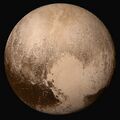Astronomy:2015 YQ1
| Discovery | |
|---|---|
| Discovered by | Mount Lemmon Srvy. |
| Discovery site | Mount Lemmon Obs. |
| Discovery date | 19 December 2015 |
| Designations | |
Designation | 2015 YQ1 |
| Minor planet category | |
| Orbital characteristics[2][3][4] | |
| Epoch 13 January 2016 (JD 2457400.5) | |
| Uncertainty parameter 6 | |
| Observation arc | 3 days |
| |{{{apsis}}}|helion}} | 1.40586 AU |
| |{{{apsis}}}|helion}} | 0.59681 AU |
| 1.00134 AU | |
| Eccentricity | 0.40398 |
| Orbital period | 1.00202 y (365.99 d) |
| Mean anomaly | 317.067° |
| Inclination | 2.4865° |
| Longitude of ascending node | 88.89770° |
| 112.185° | |
| Earth MOID | 0.00052 AU |
| Physical characteristics | |
| Dimensions | 7–16 m[a][5] |
| Absolute magnitude (H) | 28.1[2] |
2015 YQ1 (also written 2015 YQ1) is an Apollo asteroid that is a temporary horseshoe companion to the Earth, the twelfth known Earth horseshoe librator.[6] It experienced a close encounter with the Earth on 2015 December 22 at 0.0037 AU.
Discovery
2015 YQ1 was discovered on 2015 December 19 by A. D. Grauer observing with the 1.5-m reflector telescope at the Mount Lemmon Survey.[7] As of 9 March 2016, it has been observed 64 times with an observation arc of 3 days.[2]
Orbit and orbital evolution
2015 YQ1 is currently an Apollo asteroid (Earth-crossing but with a period greater than a year). Its semi-major axis (currently 1.00134 AU) is similar to that of Earth (1.00074 AU), but it has a relatively high eccentricity (0.40398) and low orbital inclination (2.4865°). It alternates between being an Aten asteroid and being an Apollo asteroid. As of 9 March 2016, this object is the 17th known Earth co-orbital and the 12th known object following a horseshoe path with respect to our planet. Asteroid 2015 YQ1 follows an asymmetrical horseshoe path with respect to our planet; the value of its relative mean longitude oscillates about 180°, but enclosing 0°; its orbital evolution is rather unstable.[6]
Physical properties
With an absolute magnitude of 28.1 mag, it has a diameter in the range 7–16 meters (for an assumed albedo range of 0.04–0.20, respectively).
See also
Notes
- ^ This is assuming an albedo of 0.20–0.04.
References
- ↑ List Of Apollo Minor Planets
- ↑ 2.0 2.1 2.2 2.3 2015 YQ1 at the JPL Small-Body Database
- Close approach · Discovery · Ephemeris · Orbit diagram · Orbital elements · Physical parameters Retrieved 2016-03-09
- ↑ AstDys-2 on 2015 YQ1 Retrieved 2016-03-09
- ↑ NEODyS-2 on 2015 YQ1 Retrieved 2016-03-09
- ↑ Absolute-magnitude conversion table (H)
- ↑ 6.0 6.1 de la Fuente Marcos, Carlos; de la Fuente Marcos, Raúl (1 April 2016). "A trio of horseshoes: past, present and future dynamical evolution of Earth co-orbital asteroids 2015 XX169, 2015 YA and 2015 YQ1". Astrophysics and Space Science 361 (4): 121 (13 pages). doi:10.1007/s10509-016-2711-6. Bibcode: 2016Ap&SS.361..121D.
- ↑ Discovery MPEC
- Further reading
- Understanding the Distribution of Near-Earth Asteroids Bottke, W. F., Jedicke, R., Morbidelli, A., Petit, J.-M., Gladman, B. 2000, Science, Vol. 288, Issue 5474, pp. 2190–2194.
- A Numerical Survey of Transient Co-orbitals of the Terrestrial Planets Christou, A. A. 2000, Icarus, Vol. 144, Issue 1, pp. 1–20.
- Debiased Orbital and Absolute Magnitude Distribution of the Near-Earth Objects Bottke, W. F., Morbidelli, A., Jedicke, R., Petit, J.-M., Levison, H. F., Michel, P., Metcalfe, T. S. 2002, Icarus, Vol. 156, Issue 2, pp. 399–433.
- Transient co-orbital asteroids Brasser, R., Innanen, K. A., Connors, M., Veillet, C., Wiegert, P., Mikkola, S., Chodas, P. W. 2004, Icarus, Vol. 171, Issue 1, pp. 102–109.
- A trio of horseshoes: past, present and future dynamical evolution of Earth co-orbital asteroids 2015 XX169, 2015 YA and 2015 YQ1 de la Fuente Marcos, C., de la Fuente Marcos, R. 2016, Astrophysics and Space Science, Vol. 361, Issue 4, article 121 (13 pp).
External links
- MPEC 2015-Y53 : 2015 YQ1, Discovery Minor Planet Electronic Circular, (at ADS)
- 2015 YQ1 data at MPC
- 2015 YQ1 at NeoDyS-2, Near Earth Objects—Dynamic Site
- Ephemeris · Obs prediction · Orbital info · MOID · Proper elements · Obs info · Close · Physical info · NEOCC
- 2015 YQ1 at ESA–space situational awareness
- 2015 YQ1 at the JPL Small-Body Database
 |





